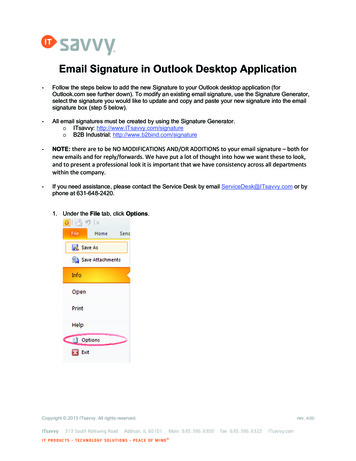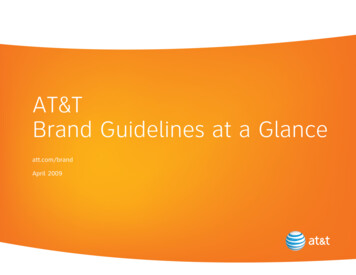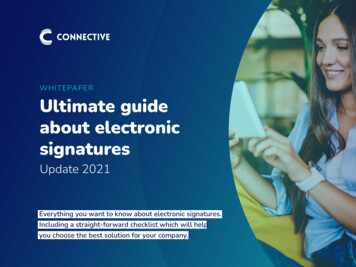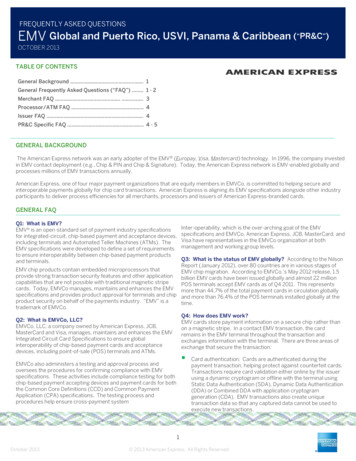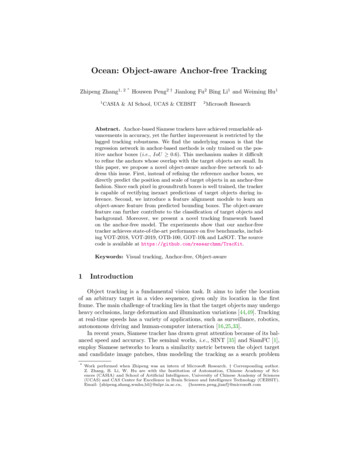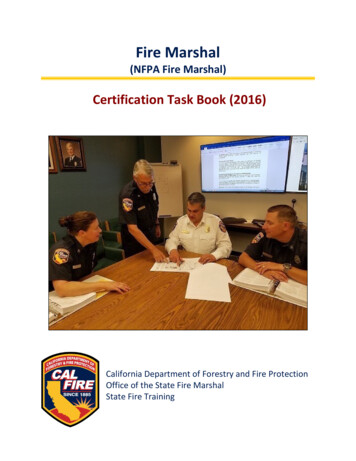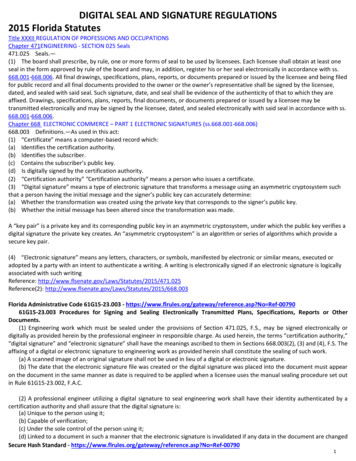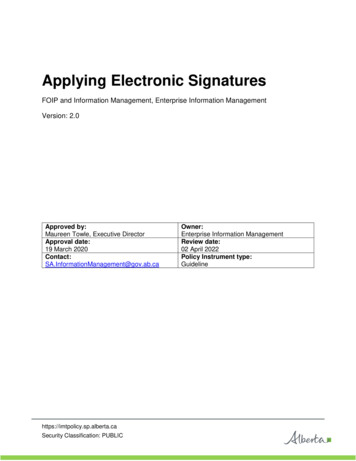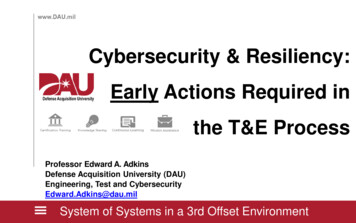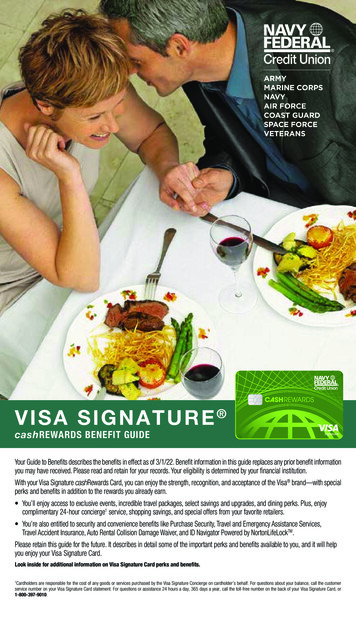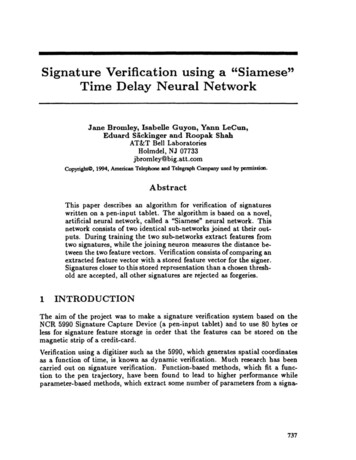
Transcription
Signature Verification using a "Siamese"Time Delay Neural NetworkJane Bromley, Isabelle Guyon, Yann LeCun,Eduard Sickinger and Roopak ShahAT&T Bell LaboratoriesHolmdel, NJ 07733jbromley@big.att.comCopyrighte, 1994, American Telephone and Telegraph Company used by permission.AbstractThis paper describes an algorithm for verification of signatureswritten on a pen-input tablet. The algorithm is based on a novel,artificial neural network, called a "Siamese" neural network. Thisnetwork consists of two identical sub-networks joined at their outputs. During training the two sub-networks extract features fromtwo signatures, while the joining neuron measures the distance between the two feature vectors. Verification consists of comparing anextracted feature vector ith a stored feature vector for the signer.Signatures closer to this stored representation than a chosen threshold are accepted, all other signatures are rejected as forgeries.1INTRODUCTIONThe aim of the project was to make a signature verification system based on theNCR 5990 Signature Capture Device (a pen-input tablet) and to use 80 bytes orless for signature feature storage in order that the features can be stored on themagnetic strip of a credit-card.Verification using a digitizer such as the 5990, which generates spatial coordinatesas a function of time, is known as dynamic verification. Much research has beencarried out on signature verification. Function-based methods, which fit a function to the pen trajectory, have been found to lead to higher performance whileparameter-based methods, which extract some number of parameters from a signa-737
738Bromley, Guyon, Le Cun, Sackinger, and Shahture, make a lower requirement on memory space for signature storage (see Loretteand Plamondon (1990) for comments). We chose to use the complete time extentof the signature, with the preprocessing described below, as input to a neural network, and to allow the network to compress the information. We believe that it ismore robust to provide the network with low level features and to allow it to learnhigher order features during the training process, rather than making heuristic decisions e.g. such as segmentation into balistic strokes. We have had success withthis method previously (Guyon et al., 1990) as have other authors (Yoshimura andYoshimura, 1992).2DATA COLLECTIONAll signature data was collected using 5990 Signature Capture Devices. They consistof an LCD overlayed with a transparent digitizer. As a guide for signing, a 1 inch by3 inches box was displayed on the LCD. However all data captured both inside andoutside this box, from first pen down to last pen up, was returned by the device.The 5990 provides the trajectory of the signature in Cartesian coordinates as afunction of time. Both the trajectory of the pen on the pad and of the pen abovethe pad (within a certain proximity of the pad) are recorded. It also uses a penpressure measurement to report whether the pen is touching the writing screen oris in the air. Forgers usually copy the shape of a signature. Using such a tabletfor signature entry means that a forger must copy both dynamic information andthe trajectory of the pen in the air. Neither of these are easily available to a forgerand it is hoped that capturing such information from signatures will make the taskof a forger much harder. Strangio (1976), Herbst and Liu (1977b) have reportedthat pen up trajectory is hard to imitate, but also less repeatable for the signer.The spatial resolution of signatures from the 5990 is about 300 dots per inch, thetime resolution 200 samples per second and the pad's surface is 5.5 inches by 3.5inches. Performance was also measured using the same data treated to have a lowerresolution of 100 dots per inch. This had essentially no effect on the results.Data was collected in a university and at Bell Laboratories and NCR cafeterias.Signature donors were asked to sign their signature as consistently as possible orto make forgeries. When producing forgeries, the signer was shown an exampleof the genuine signature on a computer screen. The amount of effort made inproducing forgeries varied. Some people practiced or signed the signature of peoplethey knew, others made little effort. Hence, forgeries varied from undetectable toobviously different. Skilled forgeries are the most difficult to detect, but in real life arange of forgeries occur from skilled ones to the signatures of the forger themselves.Except at Bell Labs., the data collection was not closely monitored so it was nosurprise when the data was found to be quite noisy. It was cleaned up according tothe following rules: Genuine signatures must have between 80% and 120% of the strokes ofthe first signature signed and, if readable, be of the same name as thattyped into the data collection system. (The majority of the signatures weredonated by residents of North America, and, typical for such signatures,were readable.) The aim of this was to remove signatures for which only
Signature Verification Using a "Siamese" Time Delay Neural Networksome part of the signature was present or where people had signed anothername e.g. Mickey Mouse. Forgeries must be an attempt to copy the genuine signature. The aim ofthis was to remove examples where people had signed completely differentnames. They must also have 80% to 120% of the strokes of the signature . A person must have signed at least 6 genuine signatures or forgeries.In total, 219 people signed between 10 and 20 signatures each, 145 signed genuines,74 signed forgeries.3PREPROCESSINGA signature from the 5990 is typically 800 sets of z, y and pen up-down points. z(t)and y(t) were originally in absolute position coordinates. By calculating the linearestimates for the z and y trajectories as a function of time and subtracting this fromthe original z and y values, they were converted to a form which is invariant to theposition and slope of the signature. Then, dividing by the y standard deviationprovided some size normalization (a person may sign their signature in a varietyof sizes, this method would normalize them). The next preprocessing step was toresample, using linear interpolation, all signatures to be the same length of 200points as the neural network requires a fixed input size. Next, further features werecomputed for input to the network and all input values were scaled so that themajority fell between 1 and -1. Ten different features could be calculated, but asubset of eight were used in different experiments:feature 1 pen up -1 i pen down 1, (pud)feature 2 x position, as a difference from the linear estimate for x(t), normalized turefeaturethe standard deviation of 1/, (x)3 y position, as a difference from the linear estimate for y(t), normalized usingthe standard deviation of 1/, (y)4 speed at each point, (spd)5 centripetal acceleration, (ace-c)6 tangential acceleration, (acc-t)7 the direction cosine of the tangent to the trajectory at each point, (cosS)8 the direction sine of the tangent to the trajectory at each point, (sinS)9 cosine of the local curvature of the trajectory at each point, (cost/J)10 sine of the local curvature of the trajectory at each point, (sint/J)In contrast to the features chosen for character recognition with a neural network(Guyon et al., 1990), where we wanted to eliminate writer specific information, thefeatures such as speed and acceleration were chosen to carry information that aidsthe discrimination between genuine signatures and forgeries. At the same time westill needed to have some information about shape to prevent a forger from breakingthe system by just imitating the rhythm of a signature, so positional, directionalamd curvature features were also used. The resampling of the signatures was suchas to preserve the regular spacing in time between points. This method penalizesforgers who do not write at the correct speed.739
740Bromley, Guyon, Le Cun, Sackinger, and ShahTARGET-. t ? - - - - - - - - - ':01 fltt. be-.112OOu . . beUliFigure 1: Architecture 1 consists of two identical time delay neural networks. Eachnetwork has an input of 8 by 200 units, first layer of 12 by 64 units with receptivefields for each unit being 8 by 11 and a second layer of 16 by 19 units with receptivefields 12 by 10.4NETWORK ARCHITECTURE AND TRAININGThe Siamese network has two input fields to compare two patterns and one outputwhose state value corresponds to the similarity between the two patterns. Twoseparate sub-networks based on Time Delay Neural Networks (Lang and Hinton,1988, Guyon et al. 1990) act on each input pattern to extract features, then thecosine of the angle between two feature vectors is calculated and this represents thedistance value. Results for two different subnetworks are reported here.Architecture 1 is shown in Fig 1. Architecture 2 differs in the number and sizeof layers. The input is 8 by 200 units, the first convolutional layer is 6 by 192units with each unit's receptive field covering 8 by 9 units of the input. The firstaveraging layer is 6 by 64 units, the second convolution layer is 4 by 57 with 6 by 8receptive fields and the second averaging layer is 4 by 19. To achieve compression inthe time dimension , architecture 1 uses a sub-sampling step of 3, while architecture2 uses averaging. A similar Siamese architecture was independently proposed forfingerprint identification by Baldi and Chauvin (1992).Training was carried out using a modified version of back propagation (LeCun, 1989).All weights could be learnt, but the two sub-networks were constrained to haveidentical weights. The desired output for a pair of genuine signatures was for asmall angle (we used cosine l.O) between the two feature vectors and a large angle
Signature Verification Using a "Siamese" Time Delay Neural NetworkTable 1: Summary of the Training.Note: GA is the percentage of genuine signature pairs with output greater than 0, FRthe percentage of genuine:forgery signature pairs for which the output was less than O.The aim of removing all pen up points for Network 2 was to investigate whether the penup trajectories were too variable to be helpful in verification. For Network 4 the trainingsimulation crashed after the 42nd iteration and was not restarted. Performance may haveimproved if training had continued past this point.pu acc-c acc-t spcosH sinS cos'" sin 2, arc 13, arc 14, arc 15, arc 2same as network 3,but a larger trainingsetsame as 4, except architecture 2 was used(we used cosine -0.9 and -1.0) if one of the signatures was a forgery. The trainingset consisted of 982 genuine signatures from 108 signers and 402 forgeries of about40 of these signers. We used up to 7,701 signature pairsj 50% genuine:genuine pairs,40% genuine:forgery pairs and 10% genuine:zero-effort pairs. 1 The validation setconsisted of 960 signature pairs in the same proportions as the training set. Thenetwork used for verification was that with the lowest error rate on the validationset.See Table 1 for a summary of the experiments. Training took a few days on aSPARe 1 .5TESTINGWhen used for verification, only one sub-network is evaluated. The output of this isthe feature vector for the signature. The feature vectors for the last six signaturessigned by each person were used to make a multivariate normal density model of theperson's signature (see pp. 22-27 of Pattern Classification and Scene Analysis byDuda and Hart for a fuller description of this). For simplicity, we assume that thefeatures are statistically independent, and that each feature has the same variance.Verification consists of comparing a feature vector with the model of the signature.The probability density that a test signature is genuine, p-yes, is found by evaluating1 zero-effort forgeries, also known as random forgeries, are those for which the forgermakes no effort to copy the genuine signature, we used genuine signatures from othersigners to simulate such forgeries.741
742Bromley, Guyon, Le Cun, Sackinger, and Shah10010Ic!10J15701050 40f3020100Ilieliea.SI290sasa.8280Percentage 01 Genuine Signatures AcceptedFigure 2: Results for Networks 4 (open circles) and 5 (closed circles). The trainingof Network 4 was essentially the same as for Network 3 except that more datawas used in training and it had been cleaned of noise. They were both based onarchitecture 1. Network 5 was based on architecture 2. The signature feature vectorfrom this architecture is just 4 by 19 in size.the normal density function. The probability density that a test signature is aforgery, p-no, is assumed, for simplicity, to be a constant value over the range ofinterest. An estimate for this value was found by averaging the p-yes values for allforgeries. Then the probability that a test signature is genuine is p-yesj(p-yes pno). Signatures closer than a chosen threshold to this stored representation areaccepted, all other signatures are rejected as forgeries.Networks 1, 2 and 3, all based on architecture I, were tested using a set of 63genuine signatures and 63 forgeries for 18 different people. There were about 4genuine test signatures for each of the 18 people, and 10 forgeries for 6 of thesepeople. Networks 1 and 2 had identical training except Network 2 was trainedwithout pen up points. Network 1 gave the better results. However, with such asmall test set, this difference may be hardly significant.The training of Network 3 was identical to that of Network I, except that x and ywere used as input features, rather than acc-c and acc-t. It had somewhat improvedperformance. No study was made to find out whether the performance improvementcame from using x and y or from leaving out acc-c and acc-t. Plamondon andParizeau (1988) have shown that acceleration is not as reliable as other functions.Figure 2 shows the results for Networks 4 and 5. They were tested using a set of532 genuine signatures and 424 forgeries for 43 different people. There were about12 genuine test signatures for each person, and 30 forgeries for 14 of the people.This graph compares the performance of the two different architectures.It takes 2 to 3 minutes on a Sun SPARC2 workstation to preprocess 6 signatures,
Signature Verification Using a "Siamese" Time Delay Neural Networkcollect the 6 outputs from the sub-network and build the normal density model.6RESULTSBest performance was obtained with Network 4. With the threshold set to detect80% of forgeries, 95.5% of genuine signatures were detected (24 signatures rejected).Performance could be improved to 97.0% genuine signatures detected (13 rejected)by removing all first and second signature from the test set 2. For 9 of the remaining13 rejected signatures pen up trajectories differed from the person's typical signature. This agrees with other reports (Strangio, 1976 Herbst and Liu, 1977b) thatpen up trajectory is hard to imitate, but also a less repeatable signature feature.However, removing pen up trajectories from training and test sets did not lead toany improvement (Networks 1 and 2 had similar performance), leading us to believe that pen up trajectories are useful in some cases. Using an elastic matchingmethod for measuring distance may help. Another cause of error came from a fewpeople who seemed unable to sign consistently and would miss out letters or addnew strokes to their signature.The requirement to represent a model of a signature in 80 bytes means that thesignature feature vector must be encodable in 80 bytes. Architecture 2 was specifically designed with this requirement in mind. Its signature feature vector has 76dimensions. When testing Network 5, which was based on this architecture, 50% ofthe outputs were found (surprisingly) to be redundant and the signature could berepresented by a 38 dimensional vector with no loss of performance. One explanation for this redundancy is that, by reducing the dimension of the output (by notusing some outputs), it is easier for the neural network to satisfy the constraint thatgenuine and forgery vectors have a cosine distance of -1 (equivalent to the outputsfrom two such signatures pointing in opposite directions).These results were gathered on a Sun SPARC2 workstation where the 38 valueswere each represented with 4 bytes. A test was made representing each value in onebyte. This had no detrimental effect on the performance. Using one byte per valueallows the signature feature vector to be coded in 38 bytes, which is well withinthe size constraint. It may be possible to represent a signature feature vector witheven less resolution, but this was not investigated. For a model to be updatable(a requirement of this project), the total of all the squares for each component ofthe signature feature vectors must also be available. This is another 38 dimensionalvector. From these two vectors the variance can be calculated and a test signatureverified. These two vectors can be stored in 80 bytes.7CONCLUSIONSThis paper describes an algorithm for signature verification. A model of a person'ssignature can easily fit in 80 bytes and the model can be updated and become moreaccurate with each successful use of the credit card (surely an incentive for peopleto use their credit card as frequently as possible). Other beneficial aspects of thisverification algorithm are that it is more resistant to forgeries for people who sign2people commented that they needed to sign a few time to get accustomed to the pad743
744Bromley, Guyon, Le Cun, Sackinger, and Shahconsistently, the algorithm is independent of the general direction of signing and isinsensitive to changes in size and slope.As a result of this project, a demonstration system incorporating the neural networksignature verification algorithm was developed. It has been used in demonstrationsat Bell Laboratories where it worked equally well for American, European andChinese signatures. This has been shown to commercial customers. We hope thata field trial can be run in order to test this technology in the real world.AcknowledgementsAll the neural network training and testing was carried out using SN2.6, a neural network simulator package developed by Neuristique. We would like to thankBernhard Boser, John Denker, Donnie Henderson, Vic Nalwa and the members ofthe Interactive Systems department at AT&T Bell Laboratories, and Cliff Mooreat NCR Corporation, for their help and encouragement. Finally, we thank all thepeople who took time to donate signatures for this project.ReferencesP. Baldi and Y. Chauvin, "Neural Networks for Fingerprint Recognition", Neural Computation,5 (1993).R. Duda and P. Hart, Pattern Classification and Scene Analysis, John Wiley and Sons,Inc., 1973.I. Guyon, P. Albrecht, Y. LeCun, J. S. Denker and W. Hubbard, "A Time Delay NeuralNetwork Character Recognizer for a Touch Terminal", Pattern Recognition, (1990).N. M. Herbst and C. N. Liu, "Automatic signature verification based on accelerometry",IBM J. Re,. Develop., 21 (1977)245-253.K. J. Lang and G. E. Hinton, "A Time Delay Neural Network Architecture for SpeechRecognition", Technical Report CMU-cs-88-152, Carnegie-Mellon University, Pittsburgh,PA,1988.Y. LeCun, "Generalization and Network Design Strategies", Technical Report CRG-TR89-4 University of Toronto Connectionist Research Group, Canada, 1989.G. Lorette and R. Plamondon, "Dynamic approaches to handwritten signature verification", in Computer processing of handwriting, Eds. R. Plamondon and C. G. Leedham,World Scientific, 1990.R. Plamondon and M. Parizeau, "Signature verification from position, velocity and acceleration signals: a comparative study", in Pro ;. 9th Int. Con. on Pattern Recognition,Rome, Italy, 1988, pp 260-265.C. E. Strangio, "Numerical comparison of similarly structured data perturbed by randomvariations, as found in handwritten signatures", Technical Report, Dept. of Elect. Eng.,1976.I. Yoshimura and M. Yoshimura, "On-line signature verification incorporating the directionof pen movement - an experimental examination of the effectiveness", in From pixel, tofeatures III: frontiers in Handwriting recognition, Eds. S. Impedova and J. C. Simon,Elsevier, 1992.
less for signature feature storage in order that the features can be stored on the magnetic strip of a credit-card. Verification using a digitizer such as the 5990, which generates spatial coordinates as a function of time, is known as dynamic verification. Much research has been carried out on signature verification.
